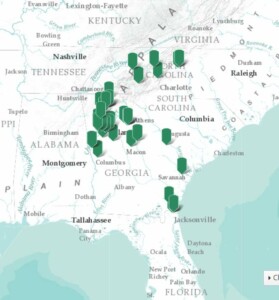Our Project Map
Southeastern Trust for Parks and Land makes use of natural land to foster natural land conservation; environmental stewardship; science education and research; and public recreation for the benefit of individuals and communities.
As our name indicates we are an active resource in land preservation and active usage spreading across the southeastern United States. We are a non-profit organization that relies on public support in the form of conservation endowment fees, privately and publicly funded grants, and financial contributions from individuals and community groups. We engage in relationships with other non-profit community groups to further the impact of our efforts.
Featured Property
Aerotropolis Nature Park
This property is located in the aerotropolis zone of Atlanta’s Hartsfield Jackson International Airport in the City of South Fulton off Camp Creek Parkway. SE Trust collaborated with Bearings Bike . . .
VIEW PROPERTYFeatured Property
Fightingtown Creek Nature Park
Fightingtown Creek Nature Park has 12 miles of flowy natural surface hike and bike trails through beautiful southern Appalachian land.
VIEW PROPERTYFeatured Property
Snapfinger Creek Nature Preserve
Snapfinger Creek Nature Preserve is 150-acres of beautiful natural land! It’s southern boundary is contiguous to I-20 west just outside of I-285. SE Trust will perpetually protect and care for . . .
VIEW PROPERTY![]()

Southeastern Trust for Parks and Land
SE Trust is a 501C3 organization dedicated to conserving land and making it available for public use 🚵♂️ CONSERVATION. RECREATION. COMMUNITY 💚📍Find your place today! #SETrust #CommunityOfHappy
![]()



